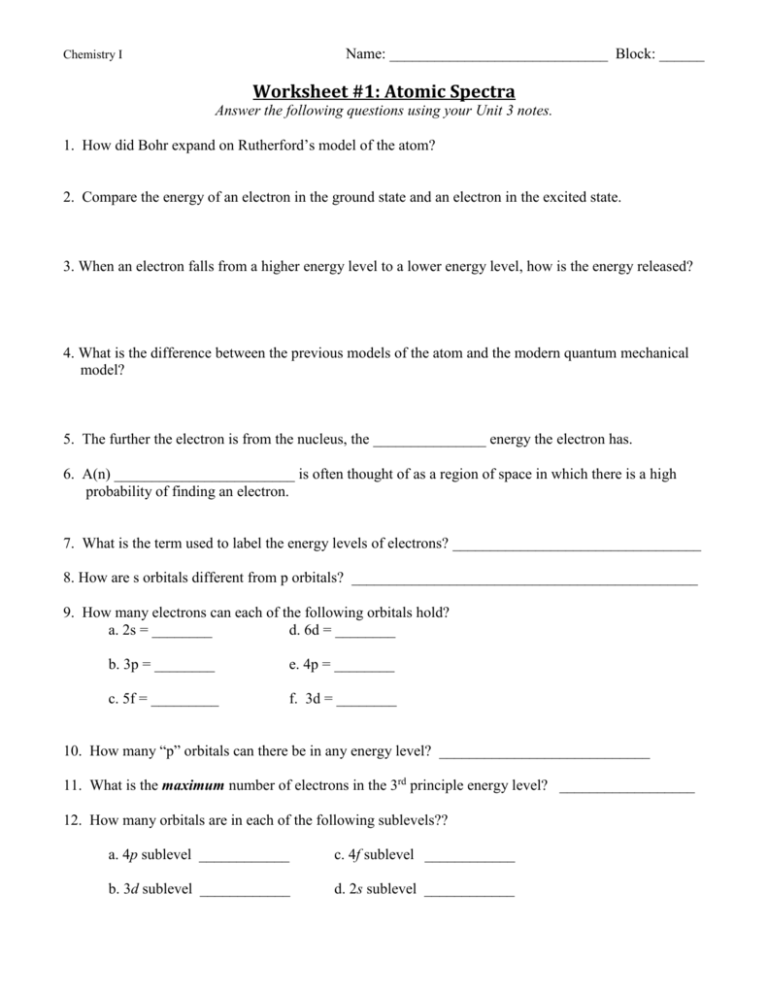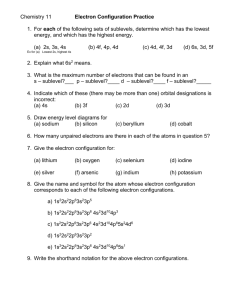Atomic orbitals worksheet
advertisement

Name: _____________________________ Block: ______ Chemistry I Worksheet #1: Atomic Spectra Answer the following questions using your Unit 3 notes. 1. How did Bohr expand on Rutherford’s model of the atom? 2. Compare the energy of an electron in the ground state and an electron in the excited state. 3. When an electron falls from a higher energy level to a lower energy level, how is the energy released? 4. What is the difference between the previous models of the atom and the modern quantum mechanical model? 5. The further the electron is from the nucleus, the _______________ energy the electron has. 6. A(n) ________________________ is often thought of as a region of space in which there is a high probability of finding an electron. 7. What is the term used to label the energy levels of electrons? _________________________________ 8. How are s orbitals different from p orbitals? ______________________________________________ 9. How many electrons can each of the following orbitals hold? a. 2s = ________ d. 6d = ________ b. 3p = ________ e. 4p = ________ c. 5f = _________ f. 3d = ________ 10. How many “p” orbitals can there be in any energy level? ____________________________ 11. What is the maximum number of electrons in the 3rd principle energy level? __________________ 12. How many orbitals are in each of the following sublevels?? a. 4p sublevel ____________ c. 4f sublevel ____________ b. 3d sublevel ____________ d. 2s sublevel ____________ Name: _____________________________ Block: ______ Chemistry I Worksheet #2: Orbital Diagrams Answer the following questions using your Unit 3 notes. 1. Fill in the electron configurations for the elements given in the table. Use the orbital filling diagrams to complete the table. Electron Configurations for Some Selected Elements Orbital filling Element 1s 2s 2px 2py 2pz 3s Electron configuration 1s1 He 1s22s1 C 1s22s22p3 O 1s22s22p5 Ne 1s22s22p63s1 2. Which element has the following orbital diagram? 1s 2s 2p 3s 3p 4s element (answer) 3d a b c 3. Using arrows, show how the following orbitals will fill with electrons. Electron Configuration 1s 2s 2p 3s 3p 2 2 6 2 Mg 1s 2s 2p 3s Cl 1s22s22p63s23p5 Si 1s22s22p63s23p2 Ti 1s22s22p63s23p64s23d2 4s 3d Name: _____________________________ Block: ______ Chemistry I Worksheet #3: Electron Configurations Answer the following questions using your Unit 3 notes. 1. Write the complete electron configuration for each atom on the blank line. a. Lithium b. Fluorine c. Carbon d. Argon e. Sulfur f. Nickel g. Rubidium h. Xeon 2. What elements are represented by each of the following electron configurations? a. 1s2 2s2 2p5 c. 1s2 2s2 2p6 3s2 3p6 4s2 3d10 4p65s2 4d10 5p4 b. 1s2 2s2 2p6 3s2 3p6 4s2 d. 1s2 2s2 2p6 3s2 3p6 4s2 3d10 4p5 3. a. What are valence electrons? _________________________________________________________ b. Explain how an atom’s valence electron configuration determines its place on the periodic table. c. List the number of valence electrons for the following atoms: potassium = magnesium = carbon = nitrogen = 4. Place the following orbitals in order of increasing energy: 1s, 3s, 4s, 6s, 3d, 4f, 3p, 7s, 5d, 5p __________________________________________ 5. What two elements are exceptions to the way we normally write electron configurations? Write the expected and the actual configuration of each. What rules are followed? What rules are violated? Name: _____________________________ Block: ______ Chemistry I Worksheet #4: Periodic Table Answer the following questions using your Unit 3 notes. 1. Identify each element as a metal, metalloid, or nonmetal. a. fluorine d. phosphorus b. germanium e. lithium c. zinc f. oxygen 2. a. Circle the transition metals below. magnesium titanium chromium mercury aluminum b. Which block (s, p, d, or f) are the transition metals found? 3. Give two examples of elements for each category. a. Noble gases b. Halogens c. Alkali metals d. Alkaline earth metals 4. Explain why the s-block of the periodic table is two groups wide, the p-block is six groups wide, and the d-block is ten groups wide. 5. Why do the elements potassium and sodium have similar chemical and physical properties? 6. Identify the element that: a. Contains a full 3rd energy level c. Outer energy level is 4s2 b. Contains 3 electrons in the 2p level d. Contains 5 electrons in the 4d level Name: _____________________________ Block: ______ Chemistry I Worksheet #4 CONTINUED….. Answer the following questions using your Unit 3 notes. 7. Write the electron configuration for the element fitting each of the following descriptions. a. The metal in Group 15 b. The halogen in period 3 c. The alkali metal in period 2 d. The transition metal that is liquid at room temperature FLASHBACK TIME !! 1. Write the electron configuration for the following elements: Cesium = _________________________________________________ Potassium = ________________________________________________ Uranium = __________________________________________________ 2. Give an example of the following: a. Homogenous mixture = _____________________________________ b. Heterogeneous mixture = ___________________________________ c. Element = ____________________ d. Compound = __________________ 3. Name the scientist who contributed the following to the discovery of the atom: a. Discovered the nucleus ______________________________ b. Used the cathode ray tube ______________________________ c. Discovered protons ______________________________ 4. How many protons, neutrons, and electrons does the element cobalt have? Name: _____________________________ Block: ______ Chemistry I Worksheet # 5: Check What Ya Know Answer the following questions using your Unit 3 notes. 1. How many orbitals are in the following sublevels? a) 3p sublevel = _____ d) 3d sublevel = _____ b) 2s sublevel = _____ e) 4f sublevel = _____ c) 4p sublevel = _____ 2. Write the full electron configuration for each atom. a) Phosphorus = _______________________________ b) Gold = _______________________________ c) Iodine = _______________________________ 3. Give the symbol and names of the elements that correspond to these configurations of an atom. Where does this element belong in the period table (e.g. noble gas, metalloid, etc..) a) 1s22s22p63s1 = ________________________ b) 1s22s22p63s23p64s23d8 = _________________________ c) 1s22s22p63s23p64s23d104p4 = ______________________________ 4. Distinguish between the ground state and the excited state of an atom. 5. Draw the orbital diagram for the element Manganese.







